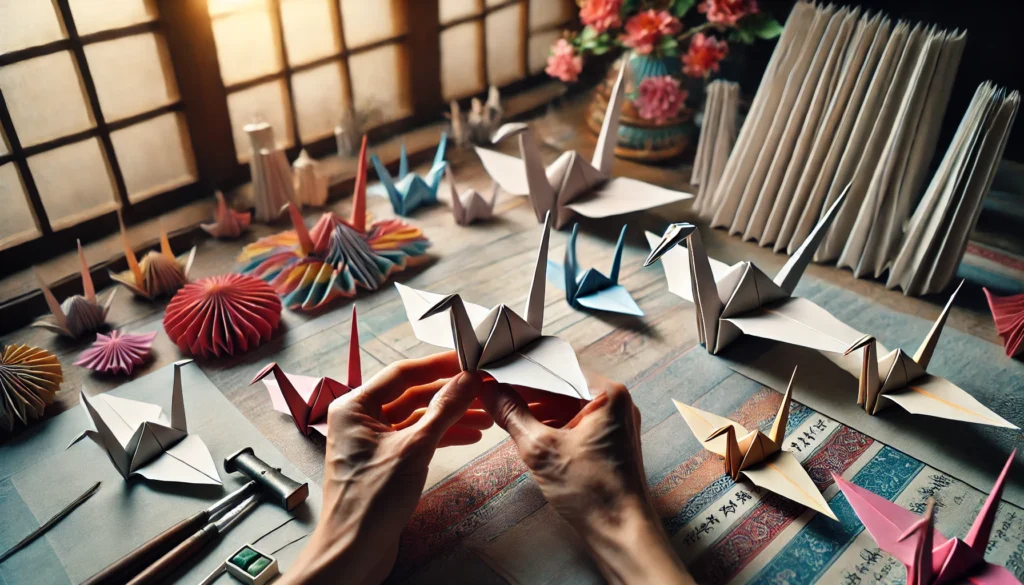Table of Contents
Introduction to Origami: Historical Background
Origami, the art of paper folding, is a practice that has its roots deeply embedded in ancient Japan. Although the exact origins are difficult to pinpoint, it is widely believed that the earliest forms of origami emerged during the Heian period (794-1185), when paper began to be imported into Japan from China. Initially, this art was not just a recreational activity; it held significant cultural and ceremonial value. For instance, origami was used in religious rituals and during wedding ceremonies, symbolizing purity and efficacy.
As time progressed, different styles of origami began to develop, marked by various historical milestones. During the Edo period (1603-1868), the practice gained popularity among the common people, leading to the establishment of the first official guides and schools dedicated to origami. This era saw the transition from origami’s ceremonial use to a more leisure-focused art form, with the creation of complex designs and intricate patterns that showcased the skill of the folder.
The evolution of origami also reflects the societal changes that occurred over centuries in Japan. The simplicity and elegance of paper folding became a metaphor for the Japanese aesthetic, emphasizing grace, precision, and the appreciation of nature. Traditional origami techniques, such as the valley fold and mountain fold, were refined, allowing practitioners to create both decorative and functional items, from delicate cranes to practical envelopes.
Modern applications of origami extend beyond art and craft, influencing fields such as engineering, mathematics, and design. Researchers have explored the potential of origami principles in multifaceted disciplines, showcasing its relevance in contemporary society while retaining its historical significance. This harmonious blend of past and present continues to inspire enthusiasts around the world, ensuring that the legacy of origami remains alive and vibrant.

The Basic Techniques of Origami
Origami, the traditional Japanese art of paper folding, encompasses a variety of techniques that serve as the foundation for its intricate designs. To master origami, understanding the basic folds is essential. The most fundamental technique is the mountain fold. This fold creates a peak or ridge in the paper, resembling a mountain’s summit. To execute a mountain fold, one must bend the paper so that the top edge folds towards the bottom edge, forming a crease at the apex. This technique is crucial for many complex patterns, as it often serves as the framework for further folds.
The valley fold is another essential technique that works in opposition to the mountain fold. In this case, the paper is folded away from the user, creating a trough-like shape resembling a valley. Specifically, to create a valley fold, the top edge of the paper is folded down towards the bottom edge, establishing a crease that helps shape the origami figure. Both mountain and valley folds are foundational in creating various structures in origami forms.
Another important technique is the squash fold. This technique allows the paper to be flattened into a shape after making an initial fold. To perform a squash fold, the desired area is gently opened up and then flattened, creating a more expansive shape. This fold is particularly beneficial when creating dimensional models, such as flowers or animals, where volume is essential.
Lastly, the reverse fold involves altering the direction of an existing fold. This technique is typically used to refine shapes or create features like limbs on animals. To execute a reverse fold, the paper is pressed in the opposite direction of the previous crease, thus transforming the model’s form. Mastering these basic techniques—mountain folds, valley folds, squashes, and reverse folds—provides the necessary skills to embark on any origami journey.
Tools and Materials for Origami
When engaging in the art of origami, the choice of paper is paramount. Traditional origami typically utilizes a specialized paper known as “washi,” a Japanese paper that is renowned for its strength and flexibility. Washi paper allows for crisp folds and retains its structure, making it ideal for intricate designs. However, contemporary origami artists often explore a variety of paper types including standard printer paper, colored craft paper, and even recycled materials, each offering unique qualities that can complement different projects.
The weight of the paper is also a critical aspect. Lightweight papers, usually around 60 to 80 grams per square meter (gsm), are easily manipulated and can hold sharp creases, making them suitable for most beginner-level models. Mid-weight papers, which range from 90 to 120 gsm, provide a balance between durability and flexibility, catering to more complex designs. For advanced origami practitioners, heavier papers exceeding 150 gsm can be utilized, although they may require more force during the folding process and can be less forgiving with intricate folds.
In addition to selecting the appropriate paper, various tools can enhance the origami experience. A bone folder, typically used to create crisp creases, is an invaluable tool for achieving precise folds. Scissors, while not commonly associated with traditional origami, can be employed for certain designs that require cut edges. Similarly, craft knives may be utilized for more delicate work where accuracy is paramount. Tweezers can be indispensable for handling smaller paper pieces, allowing for detailed work without the risk of tearing.
Ultimately, the tools and materials chosen for origami play a significant role in the final outcome of the art piece. By carefully considering the nuances of paper types, weights, and supplementary tools, artists can elevate their folding practices and outcomes, creating intricate works of beauty and craftsmanship.
Traditional Origami Figures and Their Symbolism
Origami, the intricate art of folding paper, features a plethora of traditional figures, each imbued with rich symbolism often derived from Japanese culture. Among the most iconic origami creations is the crane, a figure frequently associated with hope and healing. According to Japanese legend, folding one thousand cranes grants the folder a wish, signifying the crane’s role as a guardian of peace and longevity. This age-old belief underscores the profound emotional significance embedded within origami, where each fold serves not only to create a beautiful figure but also to reflect deeper cultural narratives.
Another popular origami figure is the frog, which traditionally symbolizes fertility, prosperity, and good fortune. This connection is rooted in the frog’s ability to leap, representing the potential for growth and transformation. Furthermore, the frog is associated with the transition between water and land, embodying a powerful metaphor for change and adaptability—attributes highly valued in Japanese society. The act of folding a frog can serve as a reminder of resilience, encouraging individuals to embrace life’s challenges and emerge stronger.
The lotus flower is yet another significant origami figure, embodying purity, enlightenment, and rebirth. In Japan, the lotus is revered for its ability to bloom elegantly even in muddy waters, thus symbolizing the notion of finding beauty and enlightenment amidst adversity. This connection to nature further enriches the symbolism inherent in origami, reinforcing the idea that artistry and nature are deeply intertwined in Japanese culture.
Through these traditional origami figures, we witness the art’s capacity to convey profound messages, weaving themes of hope, peace, and prosperity into its very fabric. Each fold and crease creates not just a shape, but also a narrative that embodies the rich tapestry of human experience. Ultimately, traditional origami acts as a bridge between artistry and meaning, reminding us of the importance of cultural heritage in contemporary expressions.
The Role of Origami in Education
Origami, the ancient Japanese art of paper folding, has found its way into modern educational settings, serving as a multifaceted tool that enhances learning across various disciplines. One of the fundamental benefits of incorporating origami into education is its strong connection to mathematical concepts. Through origami, students engage with geometry and spatial reasoning by exploring shapes, angles, and symmetry. These tactile experiences allow learners to visualize and understand complex mathematical principles in ways that traditional methods may not achieve. For example, creating various origami figures requires careful measurement and consideration of proportions, fostering a deeper appreciation for mathematics among students.
In addition to enhancing mathematical understanding, origami is instrumental in developing fine motor skills. The precise movements required for folding paper accurately engage students’ hand-eye coordination and dexterity. These skills are particularly beneficial for younger learners, as they can significantly aid in their overall physical development. Activities that promote fine motor skills also contribute to improved handwriting and other essential life skills, making origami a valuable addition to the early education curriculum.
Moreover, origami encourages creativity and critical thinking. By allowing students to experiment with different designs and techniques, origami promotes an innovative mindset. It provides a platform for students to express themselves artistically while also teaching them the importance of patience, problem-solving, and perseverance. As students encounter challenges in their paper folding journey, they learn to adapt and find solutions, which are valuable skills that extend beyond the classroom.
In summary, the integration of origami in educational settings offers a plethora of benefits. From enhancing mathematical understanding to strengthening fine motor skills and fostering creativity, origami proves to be a versatile and effective educational tool. By adopting origami in the classroom, educators can create a dynamic learning environment that captivates and inspires students of all ages.
Origami in Modern Art and Design
The ancient art of origami has transcended its traditional roots, permeating various facets of modern art and design. Artists and designers today increasingly embrace origami techniques, incorporating its intricate folds and forms to create visually striking pieces that challenge conventional aesthetics. This influence is evident in multiple domains, including graphic design, ceramics, and contemporary sculpture. By adopting origami methods, creators can explore the narrative potential of paper and the inherent beauty of transformation through folds.
In the realm of architecture, origami’s impact is particularly significant. Architects draw inspiration from origami’s geometric principles to develop innovative structures that are not only aesthetically pleasing but also practical. The potential for folding and unfolding in designs allows for space efficiency and adaptability in various building applications. Notable examples include the “Origami” pavilion in Spain and the work of architects like Shigeru Ban, who employ cardboard and paper to create functional and sustainable living spaces. Such projects underscore the capability of origami to bridge the gap between art and architecture, promoting sustainable design methodologies.
Fashion design has also witnessed the integration of origami aesthetics, with designers using folding techniques to create garments that are both sculptural and wearable. Fashion collections often feature intricate pleats and folds reminiscent of origami, enhancing the texture and movement of the fabric. This connection illustrates how a traditional practice can evolve into a source of inspiration across industries, pushing the boundaries of creativity while maintaining a dialogue with its heritage.
Ultimately, origami’s role in modern art and design serves to highlight the timelessness of this practice. As it continues to inspire contemporary artists and creators, the ancient art form reaffirms its place within the fabric of modern culture, showcasing the seamless blend of tradition and innovation.
Innovations and Technology in Origami
Origami, the ancient Japanese art of folding paper, has transcended its traditional boundaries, influencing modern technology and engineering. This intersection is particularly evident in the fields of robotics, medical devices, and sustainable design. By applying origami principles, engineers are developing innovative solutions that address complex challenges in these areas.
In robotics, origami-inspired designs enable the creation of compact mechanisms that can expand and contract efficiently. This adaptability is crucial for applications where space and weight are critical factors, such as in miniature robots used for search and rescue missions. The ability to fold structures into compact volumes allows for easy transportation and deployment, demonstrating the practical utility of integrating origami concepts into robotic engineering.
Another significant application of origami principles can be observed in the medical field. Researchers are leveraging the art of folding to design advanced medical devices that are less invasive and more efficient. For instance, origami techniques are being used to develop stents and other implants that can be compressed for insertion but expand once inside the body. This innovation not only improves patient comfort but also enhances the device’s functional capabilities.
Furthermore, sustainable design is experiencing a transformation through origami-inspired solutions. Architects and designers are exploring the use of foldable structures that minimize material waste while maximizing structural integrity and visual appeal. Origami’s inherent efficiency allows for the creation of adaptable buildings and furniture that can be easily transported and assembled, thus promoting eco-friendly practices in construction and design.
As advancements in engineering and technology continue to evolve, the integration of origami principles is likely to unleash further innovations across various industries. The harmonious blend of art and science exemplifies the enduring relevance of origami, showcasing that its teachings are not solely confined to paper but can inspire creativity and functionality in the modern world.
Origami as a Therapeutic Practice
Origami, the ancient Japanese art of paper folding, transcends mere craftsmanship; it serves as a powerful vehicle for therapeutic benefit. The act of folding paper into intricate shapes not only engages fine motor skills but also promotes mindfulness, a crucial component in modern mental wellness practices. In this context, origami can be considered a form of art therapy, offering various psychological advantages.
One significant benefit of practicing origami is its ability to foster relaxation and relieve stress. Engaging in this art form requires concentration, drawing the participant’s attention away from everyday anxieties. As practitioners focus on the precise movements needed to create a design, they enter a state of flow, a mental state characterized by complete involvement and enjoyment. This immersion helps reduce levels of cortisol, the stress hormone, contributing to an overall sense of calm and well-being.
Additionally, origami serves as a medium for self-expression. For individuals who may struggle to articulate their emotions verbally, the act of folding can become a channel for conveying feelings and thoughts. This form of expression can be particularly beneficial for those dealing with mental health challenges, such as anxiety or depression. By manipulating paper, individuals often find clarity and insight into their emotions, which is therapeutic and can lead to personal growth.
Moreover, origami can be integrated into group therapy settings, enhancing social connections. Participating in a shared activity fosters communication and cooperation among individuals, combating feelings of isolation that many may experience. Whether in a clinical setting or a casual group, the collective experience of creating origami sculptures can build camaraderie and support, enhancing the therapeutic outcome.
In conclusion, the therapeutic benefits of origami extend far beyond artistic creation. By promoting mindfulness, facilitating emotional expression, and encouraging social interaction, origami emerges as a valuable tool for enhancing mental wellness in individuals across diverse backgrounds and experiences.

Getting Started with Origami: Resources and Communities
Embarking on your origami journey can be both exhilarating and rewarding, as this ancient Japanese art form offers endless creative possibilities. To begin, one can explore a variety of resources designed to help individuals of all skill levels, from beginners to advanced folders. A selection of recommended books includes titles such as “The Joy of Paper Folding” by Margaret Van Sicklen and “Origami Design Secrets” by Robert J. Lang, which provide detailed instructions and insights into the principles behind this intricate art.
Additionally, numerous online platforms serve as excellent tools for learning origami. Websites like Origami USA and YouTube feature a plethora of video tutorials, ranging from simple designs to complex models, allowing users to visually follow along with step-by-step guidance. For those seeking a more interactive experience, platforms such as Skillshare and Udemy offer structured classes where participants can learn in real-time while receiving feedback from instructors.
Moreover, local clubs and workshops can significantly enrich the origami experience. Many communities host origami groups that welcome enthusiasts of all levels to gather, share techniques, and work on projects together. Attending these events not only improves one’s folding skills but also fosters connections with fellow origami lovers. Websites like Meetup or local community centers often list such clubs and workshops, making it easy for individuals to find opportunities nearby.
Connecting with the global origami community opens doors to a wealth of inspiration and support. Online forums, social media groups, and dedicated origami websites provide an avenue for exchanging ideas, showcasing completed projects, and receiving constructive criticism. By engaging with others who share a passion for paper folding, beginners can overcome challenges and refine their technique, ultimately enhancing their enjoyment of this captivating art form.






